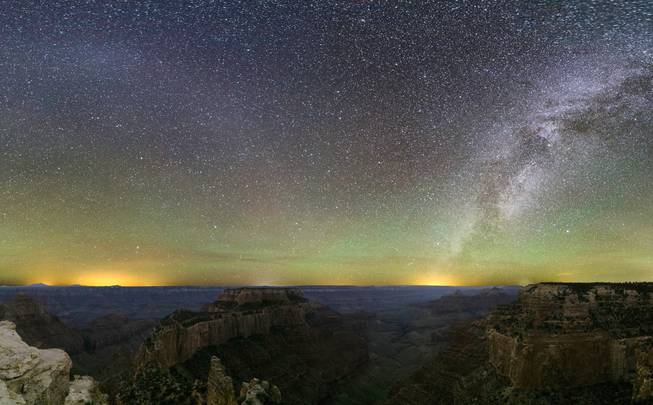
Jeremy White/National Park Service via The New York Times
A photo provided by the National Park Service shows the Milky Way as seen from Cape Royal on the North Rim of the Grand Canyon. Three urban areas emanate haloes of light, from left: Flagstaff, Ariz., Phoenix and Prescott, Ariz., and Las Vegas. A new interactive atlas has been released showing the global effects of artificial light on views of the stars from Earth.
Saturday, June 11, 2016 | 6:04 a.m.
Stargazers from around the globe gathered at the Grand Canyon this week to gander upon our galaxy’s grandeur. The national park is hosting its annual star party, an eight-night event inviting the public to observe the heavens free from blinding city lights and street lamps.
“As the sky gets darker after sunset, you start to notice something on the eastern horizon that at first you think are storm clouds,” said John Barentine, an astronomer and program manager at the International Dark-Sky Association, a nonprofit group that raises awareness to light pollution. “Then as it gets darker, you realize they aren’t clouds in our atmosphere, but they are glowing clouds of stars.”
What he and thousands of visitors witnessed was a sight hidden to many: the Milky Way.
“One third of humanity cannot see the Milky Way,” said Fabio Falchi, a researcher from the nonprofit organization the Light Pollution Science and Technology Institute in Italy. “It is the first time in human history that we have lost the direct contact with the night sky.”
Falchi and a cohort of dark-night knights have spent the past year creating an interactive world atlas that shows the global effect of artificial light on how most of us see the sky after the sun sets. They released the map to the public on Friday in the journal Science Advances. The new atlas is an improved version of their original one, which was released in 2001.
The color-coded map, using data collected by the Suomi NPP satellite, quantifies the brightness of the night sky across the world, ranging from dark, pristine views like that over the ocean, to major cities where artificial light has completely obliterated the natural darkness.
By comparing the brightness atlas with population density maps, the team found that light pollution affects 80 percent of the world’s population, and that two out of three Europeans and four out of five Americans live in areas where light masks the Milky Way.
The hearts of major cities like London, Las Vegas and Tokyo are white hot on the atlas, while their neighboring suburbs are covered in splotches of orange, red, magenta and pink. Places like the Grand Canyon and most of Africa and Australia are colored in black, gray and dark blue.
“It demonstrates just how far lights from large metropolitan areas spread through the atmosphere,” said Dan M. Duriscoe, a physical scientist from the National Park Service, who contributed to the atlas. “Observers on the ground hundreds of kilometers away are still under the influence of that light.”

Join the Discussion:
Check this out for a full explanation of our conversion to the LiveFyre commenting system and instructions on how to sign up for an account.
Full comments policy